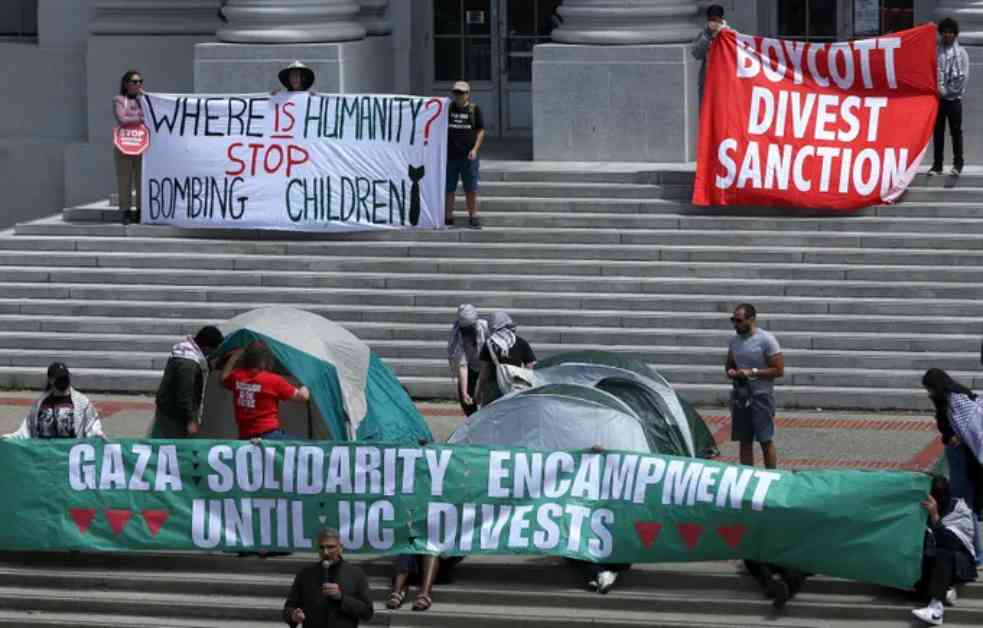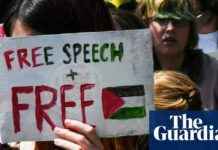University Protest Policies Tighten for Fall Semester
As universities in California gear up for the start of the fall semester, both the University of California and the California State University systems are implementing stricter rules and revising policies regarding protests and demonstrations on campus.
Cal State’s new public assembly policy, unveiled recently, prohibits encampments, unauthorized structures, and demonstrators from wearing disguises or concealing their identities. These rules will supersede any existing regulations at individual campuses within the system. Hazel Kelly, a spokesperson for Cal State, clarified that these requirements were largely already in place at each university and the Chancellor’s Office.
University of California President Michael Drake has directed campus leaders to establish or reinforce policies that ban encampments, unauthorized structures, and restrictions on free movement. Additionally, demonstrators are now prohibited from concealing their identities with masks. These changes come in response to the challenges faced by both systems during student protests over the Israel-Hamas conflict that resulted in unrest across campuses during the previous spring term.
Size and Scope of Cal State and University of California Systems
Both the Cal State and University of California systems are significant players in higher education, collectively serving a substantial portion of the nation’s college-going population. Cal State is one of the largest public college systems in the country, comprising approximately 455,000 students spread across 23 campuses. The University of California, with its 10 campuses, enrolls around 296,000 students.
In anticipation of potential campus protests in the upcoming fall term, both systems have issued new policy directives. However, their approaches to addressing these issues differ in some respects.
Cal State’s Systemwide Policy and Guidelines
Cal State’s policy emphasizes systemwide rules aimed at ensuring the right of free expression while maintaining the integrity of university operations. Demonstrators are granted access to public areas without the need for scheduling or reservations, as long as their activities do not disrupt university functions. The policy also prohibits protesters from interfering with others’ speech.
While the new policy sets overarching guidelines, individual universities within the Cal State system have the flexibility to define specific details, such as delineating public spaces. As of now, seven out of Cal State’s 23 campuses have published their individual policies on the system’s website.
One notable aspect of the policy is the lack of clarity on how enforcement will handle situations where individuals wear masks to conceal their identities. This ambiguity raises questions about the practical application of the rules on various campuses.
The need for a comprehensive approach to managing protests became evident following incidents during the previous spring term. At Sonoma State University, for instance, the president’s resignation was prompted by his unauthorized agreement to support an academic boycott of Israel, a decision that contradicted Cal State’s official stance.
University of California’s Response and State Funding
Unlike Cal State’s systemwide policy, the University of California did not unilaterally establish protest guidelines for its campuses. However, President Michael Drake emphasized the importance of reinforcing existing bans on practices like mask-wearing to conceal identity.
A key factor influencing the University of California’s actions is the withholding of $25 million in state funding until a systemwide framework for free speech rules is developed and implemented by October 1. This financial pressure underscores the need for consistent policies across all member campuses.
Drake, who is set to conclude his tenure as system leader in the coming academic year, stressed the importance of creating a framework for the implementation and enforcement of protest policies. Additionally, the University of California is working on campus climate action plans to address concerns related to protest activities.
Throughout the summer, university leaders engaged with students and employees to gather input on public assembly policies with the aim of fostering an environment that upholds free expression while ensuring safety and lawful conduct.
The events of the previous semester underscored the challenges universities face in balancing free speech rights with maintaining order and safety on campus. The violent clashes on the UCLA campus highlighted the need for clear guidelines and effective enforcement mechanisms to prevent similar incidents in the future.
In conclusion, as universities prepare for the fall semester, the tightening of protest rules and the implementation of stricter policies reflect the ongoing efforts to strike a balance between upholding free expression and ensuring the safety and well-being of the campus community. By clarifying guidelines, engaging stakeholders, and enforcing regulations consistently, institutions aim to create a conducive environment for dialogue and peaceful activism while safeguarding the rights and interests of all individuals involved.



